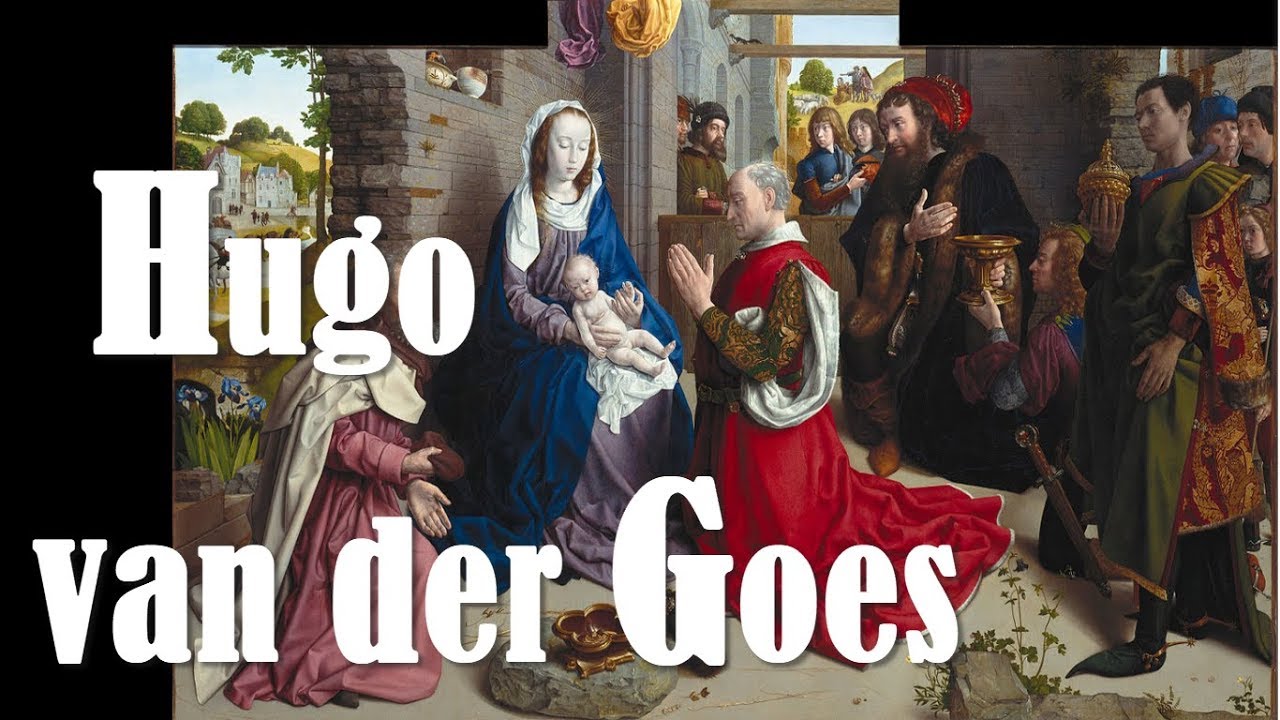Life
In 1467, Hugo van der Goes enrolled as master in the Ghent painters’ guild, sponsored by Joos van Wassenhove, master painter in Ghent in 1464 after registering in Antwerp in 1460. In 1469 the two together acted as guarantors for the illuminator Sanders Bening when he became a master, and it was from Hugo that Joos borrowed money when he went to Rome. Sanders Bening was married to Kathelijn van der Goes, perhaps Hugo’s sister. Hugo’s status within the guild is further attested by the fact that he was guarantor for two other painters in 1471 and 1475, that he was one of the dean’s jurors in 1468–9 and that he himself served as dean from towards the end of 1473–4 to at least 18 August 1475. He was employed regularly by the town of Ghent between 1468 and 1474 for the decorative ephemera essential to the pageants of public life.
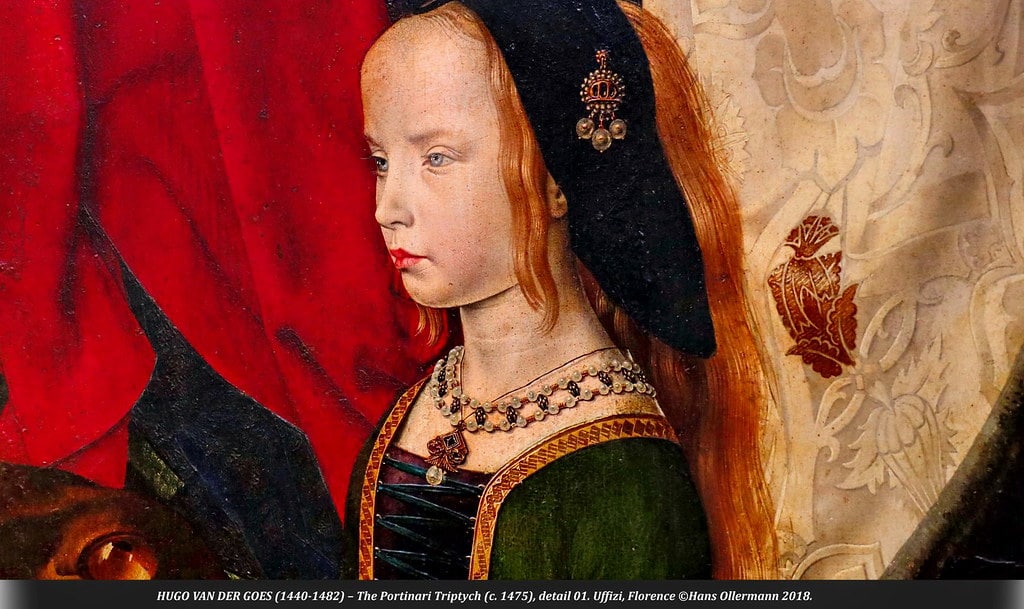
Van der Goes’s reputation extended beyond Ghent, for he was one of the many painters called to Bruges for the celebrations on the marriage of Charles the Bold with Margaret of York in 1468. His pay of 14 sols a day compares unfavorably with the 20 sols plus 3 sols expenses paid to Daniel de Rijke, another Ghent painter. In 1480, however, when the town of Leuven employed him to evaluate paintings left unfinished when Dieric Bouts died in 1475, he was honored with a gift of wine and was described in the accounts as one of the most notable painters to be found.
By this date, Hugo had become a frater conversus, or lay brother, in the monastery of the Rode Klooster in the Forêt de Soignes near Brussels, where his half-brother Nicholas was also a monk. The precise year of Hugo’s entry is not recorded. Between May 1473 and May 1477, he was the tenant of a house in the St Pieters Nieuwstraat in Ghent belonging to the van der Sickele family, and he last appears in their accounts in March 1478. He may have stopped living there somewhat earlier, for Gaspar Ofhuys, who joined the Rode Klooster in 1475, maintained that he and Hugo were novices together. Ofhuys discussed Hugo at length in his early 16th-century chronicle of the monastery, not so much for the painter’s fame, which was so great that ‘people used to say that he had no equal this side of the Alps’, as for the moral lessons to be drawn from his lapse into insanity. According to Ofhuys, Hugo was travelling back from Cologne, some five or six years after becoming a monk, when conviction of his damnation drove him to frenzy and he had to be restrained from injuring himself. He was treated gently on his return and recovered, only to die shortly afterwards.
Ofhuys’s account reveals that Hugo continued to practice as a painter after entering the monastery and to attract the attention of the great of the world, who came to see his pictures and gossiped about his madness. He was given special privileges to entertain his visitors, among them Archduke Maximilian, and Ofhuys concluded that, in trying to achieve the anonymity of the cloister, Hugo actually acquired greater personal fame. Hugo seems to have accepted that he was guilty of pride, since he renounced any special favours when he recovered from his illness and lived as the others, ‘continually reading in a Flemish book’. Anxiety about his art may have contributed to his madness, for ‘he was deeply troubled by the thought of how he would ever finish the works of art he had to paint, and it was said then that nine years would scarcely suffice’. He was buried simply in the cloister under the open sky, but in his epitaph Art was told to lament, for his equal would never be found.
Work of Hugo van der Goes
Nothing survives of the ephemera Hugo painted for the town of Ghent, and no painting can be authenticated as his from contemporary evidence. A painting of David and Abigail, attributed to Hugo by three 16th-century writers, is now known through some 20 later copies. A triptych of the Virgin and Child with Prophets and Sibyls by Hugo was owned by the humanist scholar Jerome Busleyden (d 1517) and is reflected in three derivative works: a panel by Ambrosius Benson (Antwerp, Kon. Mus. S. Kst), the center of a triptych by the Master of the Holy Blood and a miniature in the style of Simon Bening.
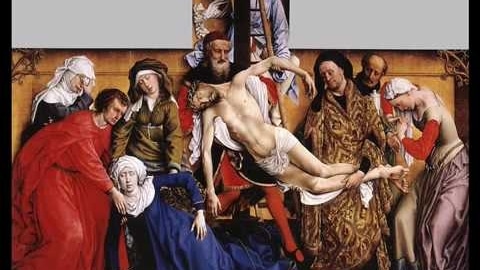 Hugo van der Goes: Portinari Altarpiece, oil on panel, central…The two lost originals seem from these later versions to have been consistent in style with the Portinari Altarpiece (Florence, Uffizi), the only surviving work attributable to Hugo from a 16th-century source. In the first edition of the Vite (1550) Vasari wrote that the picture at S Maria Nuova in Florence was by ‘Ugo d’Anversa’. This picture is assumed to be the Portinari Altarpiece, a large triptych with the Nativity or Adoration of the Shepherds (central panel, 2.53×3.04 m) from the church of S Egidio in the hospital of S Maria Nuova, and ‘Ugo d’Anversa’ to be Hugo van der Goes, who is not otherwise linked with Antwerp. (By 1550 it may have been as natural to associate all Netherlanders with Antwerp as it had been in the 15th century to think of Bruges.) The patrons of S Maria Nuova were the Portinari family, and it was Tommaso Portinari, agent for the Medici bank in Bruges, who commissioned the altarpiece as his contribution to the recently rebuilt S Egidio. Tommaso is shown on the left wing with his sons Antonio and Pigello, presented by SS Thomas and Anthony, and his wife, Maria Baroncelli, on the right wing with their daughter, Margherita, and SS Mary Magdalene and Margaret. The commission can be dated between 1473, the earliest possible birth date of Pigello, their third child, and 1478, the probable birth date of Guido, their fourth. The discovery (see Marijnissen and van de Voorde) that Tommaso’s head, but not Maria’s, had been painted on to a separate support and then glued to the panel suggests that Hugo was working on the wings in 1477–8, when Tommaso was in Italy but his family still in the southern Netherlands. The wings must have been insufficiently advanced before his departure for his appearance to be recorded directly on to the panel as was his wife’s. Stylistic and technical differences suggest that the wings were painted later than the central panel (see Thompson and Campbell), which would have been begun c. 1473–4. Whether because of Hugo’s working methods or the chaos in Portinari’s affairs after the death of Charles the Bold in 1477, the altarpiece did not arrive in Florence until 1483. It had a great impact on Italian painters and was a major source for Domenico Ghirlandaio’s Adoration of the Shepherds (1485; Florence, Uffizi).
Hugo van der Goes: Portinari Altarpiece, oil on panel, central…The two lost originals seem from these later versions to have been consistent in style with the Portinari Altarpiece (Florence, Uffizi), the only surviving work attributable to Hugo from a 16th-century source. In the first edition of the Vite (1550) Vasari wrote that the picture at S Maria Nuova in Florence was by ‘Ugo d’Anversa’. This picture is assumed to be the Portinari Altarpiece, a large triptych with the Nativity or Adoration of the Shepherds (central panel, 2.53×3.04 m) from the church of S Egidio in the hospital of S Maria Nuova, and ‘Ugo d’Anversa’ to be Hugo van der Goes, who is not otherwise linked with Antwerp. (By 1550 it may have been as natural to associate all Netherlanders with Antwerp as it had been in the 15th century to think of Bruges.) The patrons of S Maria Nuova were the Portinari family, and it was Tommaso Portinari, agent for the Medici bank in Bruges, who commissioned the altarpiece as his contribution to the recently rebuilt S Egidio. Tommaso is shown on the left wing with his sons Antonio and Pigello, presented by SS Thomas and Anthony, and his wife, Maria Baroncelli, on the right wing with their daughter, Margherita, and SS Mary Magdalene and Margaret. The commission can be dated between 1473, the earliest possible birth date of Pigello, their third child, and 1478, the probable birth date of Guido, their fourth. The discovery (see Marijnissen and van de Voorde) that Tommaso’s head, but not Maria’s, had been painted on to a separate support and then glued to the panel suggests that Hugo was working on the wings in 1477–8, when Tommaso was in Italy but his family still in the southern Netherlands. The wings must have been insufficiently advanced before his departure for his appearance to be recorded directly on to the panel as was his wife’s. Stylistic and technical differences suggest that the wings were painted later than the central panel (see Thompson and Campbell), which would have been begun c. 1473–4. Whether because of Hugo’s working methods or the chaos in Portinari’s affairs after the death of Charles the Bold in 1477, the altarpiece did not arrive in Florence until 1483. It had a great impact on Italian painters and was a major source for Domenico Ghirlandaio’s Adoration of the Shepherds (1485; Florence, Uffizi).
The distance is not large between Ghent and Bruges, where Hugo is known to have worked in 1468 and where paintings by him were recorded in the 16th century. Portinari had already commissioned work from Hans Memling, resident in Bruges; whether he turned to Hugo for practical or aesthetic reasons, he obtained in the altarpiece a triptych far removed from Memling’s reassuring art. In the central panel, single vanishing-point perspective, focused on the Virgin’s face, establishes a steeply raked stage for the figures, who contradict the logic of the spatial construction by their discrepancies in scale. The unsteady pose of the small figure of Joseph is given an appearance of stability by the solidity of his contour and the firmness of his praying hands. His motionless pose offsets the busyness of the shepherds, who thrust forward as if against an invisible barrier around the isolated and vulnerable Child, laid on the ground as sacrificial victim, yet worshipped as God. The flowers and wheatsheaf, symbols of the Eucharistic Passion and the Sorrows of the Virgin, complete the circle. While the setting is continuous across the three panels, the wings, where saints tower over donors in the shallow foreground, are different in conception and technique. Shut, they show a grisaille Annunciation, set in sculptural niches but incapable of ever being carved in stone.
The idiosyncrasies of the Portinari Altarpiece have left little disagreement about the other major works to be attributed to Hugo. Another large altarpiece for export, for Trinity College, Edinburgh, was commissioned between 1473 and 1478 (wings, both 1990×970 mm, Brit. Royal Col., on loan to Edinburgh, N.G.), judging by the appearance in the left wing of only the eldest son of James III of Scotland, kneeling behind his father and before the standing figure of St Andrew. A saint in armor, probably St George, presents the Queen, Margaret of Denmark, in the right wing. The lost central panel may have been a Virgin and Child Enthroned, perhaps the model for the Goesian central panel of the Évora Altarpiece in Portugal (Évora, Mus. Évora). On the reverse of the panels a Trinity to the left is adored on the right by Edward Bonkil, the Provost of Trinity College, with music-making angels. Bonkil’s individualized features show that he must have commissioned the triptych and sat for his portrait when in the southern Netherlands, with which his family had substantial trading connections.
Hugo van der Goes: Adoration of the Magi (Monforte altarpiece),…There is no external evidence for dating the other large panels attributed to Hugo. The Death of the Virgin (1.47×1.21 m; Bruges, Groeningemus.) comes from the Cistercian abbey of Ter Duinen in west Flanders, which may have been its original destination, for its starkness is appropriate to a Cistercian commission. Two paintings (both Berlin, Gemäldegal.) came from Spain, which they may only have reached in the 16th century: the unusual shape of the Nativity or Adoration of the Shepherds (970×2450 mm; see fig. below) suggests that it was made for a specific place or function not recorded; the Adoration of the Magi (1.42×2.45 m came from the monastery of Monforte, near Lemos, not founded until 1593. The Monforte Adoration has lost the top of the raised central section and its wings, which may have shown a Nativity and Circumcision on the pattern of the wings that accompany a reversed version of the Monforte Adoration by the Master of Frankfurt (Antwerp, Kon. Mus. S. Kst).
Hugo van der Goes: Lamentation (panel from a diptych), oil…Among Hugo’s smaller works, the left wing of the St Hippolytus triptych (Bruges, St Salvator), otherwise attributed to Dieric Bouts, can be dated c. 1475 from the dress of the Bruges couple portrayed on it, Hippolyte de Berthoz and Elizabeth de Keverwyck. The costume of Willem van Overbeke and Johanna de Keysere, shown on the wings of a small Virgin and Child by Hugo (central panel, 210×140 mm; Frankfurt am Main, Städel. Kstinst. & Städt. Gal.), indicates that they did not have the picture enshrined in a triptych until some ten years after Hugo’s death. The remains of a collar, possibly of the Golden Fleece, and his patron saint, John the Baptist, are the only clues to the identity of a man on what was probably the right wing of a diptych (cut at top and bottom, 322×225 mm; Baltimore, MD, Walters A.G.). Traces of a heraldic motif on the back of a Lamentation, the right wing of a diptych formed with the Fall of Man (each panel 338×230 mm; Vienna, Ksthist. Mus.), and the figure of St Genevieve on the now detached reverse of the latter show that this was another special commission.
Other compositions that appear to have originated with Hugo are now known only from copies and derivations, most completely assembled by Winkler. The popularity of his works continued into the 17th century, although their artist was largely forgotten. His name did not have the selling power of Bosch’s and was not added to the numerous replicas of his most famous inventions.
Stylistic Development
Conventional categories of early, middle and late works seem inappropriate to an artist who was an independent master for only 15 years. They become hard to avoid if the Portinari Altarpiece is taken as a dateable and, to an extent, authenticated mid-point and other works judged earlier or later. Van Mander seems to have put a chronological interpretation on changes in Hugo’s style, since he recognized a now lost Legend of St Catherine as a youthful work. Allowing for differences in scale and intent, it is possible to see a coherent development from the Monforte Adoration to the Portinari central panel followed by the wings (see fig.), which are very close to the Scottish Bonkil wing panels, and finally to the Nativity and Death of the Virgin. Friedländer’s attempts to find pictures surviving in the original that antedate the Monforte Adoration have not gained general acceptance, for his candidates seem the works of weaker imitators rather than of the young Hugo.
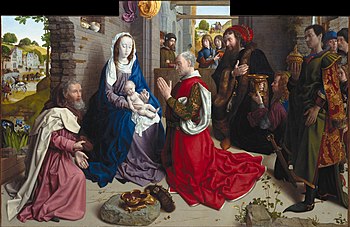 Hugo van der Goes: Fall of Man (panel from a…The development can be summarized as a move from illusionism, based on Eyckian techniques of detailed description in rich colour and single vanishing-point perspective, perhaps learnt from Petrus Christus or Dieric Bouts and used in the Monforte Adoration and Portinari central panel (see fig.), to an increasing emphasis on the artificiality of the picture as created image, divorced from reality by the use of limited colour and the expressive distortion of both the figures and space, as in the Death of the Virgin. Pächt was one of the few scholars to reject this interpretation; there has been more disagreement on relating the smaller works to it. The abstract, gold-patterned background of the Virgin and Child, the space-denying compression of the unidentified donor wing (Baltimore, MD, Walters A.G.) and the contrast of the continuous landscape inhabited by Adam and Eve in the Fall of Man with the impossible grouping of the Lamentation all serve to associate these works with the later phase of Hugo’s style. The latter diptych, however, demonstrates his ability to compose very different types of picture at the same time, since he balances the two panels through a deliberate contrast, essential to their meaning both individually and in conjunction. Such contrasts are found also in the Bonkil panels and in two diptych compositions that seem to have originated with Hugo, an Annunciation, as painted by the Master of 1499 (Berlin, Bodemus.), and a St Luke Drawing the Virgin (Lisbon, Mus. N. A. Ant.; known also through a print by Anton Wierix). Hugo had the confidence to use or discard techniques as they suited his purpose, and this makes rigid conclusions on dating difficult.
Hugo van der Goes: Fall of Man (panel from a…The development can be summarized as a move from illusionism, based on Eyckian techniques of detailed description in rich colour and single vanishing-point perspective, perhaps learnt from Petrus Christus or Dieric Bouts and used in the Monforte Adoration and Portinari central panel (see fig.), to an increasing emphasis on the artificiality of the picture as created image, divorced from reality by the use of limited colour and the expressive distortion of both the figures and space, as in the Death of the Virgin. Pächt was one of the few scholars to reject this interpretation; there has been more disagreement on relating the smaller works to it. The abstract, gold-patterned background of the Virgin and Child, the space-denying compression of the unidentified donor wing (Baltimore, MD, Walters A.G.) and the contrast of the continuous landscape inhabited by Adam and Eve in the Fall of Man with the impossible grouping of the Lamentation all serve to associate these works with the later phase of Hugo’s style. The latter diptych, however, demonstrates his ability to compose very different types of picture at the same time, since he balances the two panels through a deliberate contrast, essential to their meaning both individually and in conjunction. Such contrasts are found also in the Bonkil panels and in two diptych compositions that seem to have originated with Hugo, an Annunciation, as painted by the Master of 1499 (Berlin, Bodemus.), and a St Luke Drawing the Virgin (Lisbon, Mus. N. A. Ant.; known also through a print by Anton Wierix). Hugo had the confidence to use or discard techniques as they suited his purpose, and this makes rigid conclusions on dating difficult.
In the Bonkil panels and the latter two diptych compositions, a human is shown in a detailed interior in one panel, aware of a divine vision or visitation on the other panel, where the formalized setting has no clear spatial relationship to the interior. The division inherent in a two-panel design was stressed, not denied, in order to clarify the different levels of reality depicted. A distinction through contrasting settings was impossible in unified compositions; instead scale was used in the Portinari Altarpiece and framing devices in the interiors of the Bonkil panels with their curtained chapelles to divorce the living from the central image. Internal framing both divides the scene represented and distances the viewer from an image that is not to be read as a straightforward extension of reality. The barrier between viewer and image is most explicit in the Nativity, where two half-length figures in the foreground, assumed to be prophets, pull aside a curtain to unveil the Holy Family (see fig. below). One of the prophets glares out at the viewer and, like the curtain rail physically raised in relief to enter the spectator’s space, serves both to welcome and to repel. Hugo’s use of figures turned to look outwards is most extreme in the Death of the Virgin, where the central seated figure seems almost unaware of the Virgin behind him. The contradictory spatial indications in this picture make any formal devices unnecessary to emphasize its artificiality as illusion, its reality as painted image.
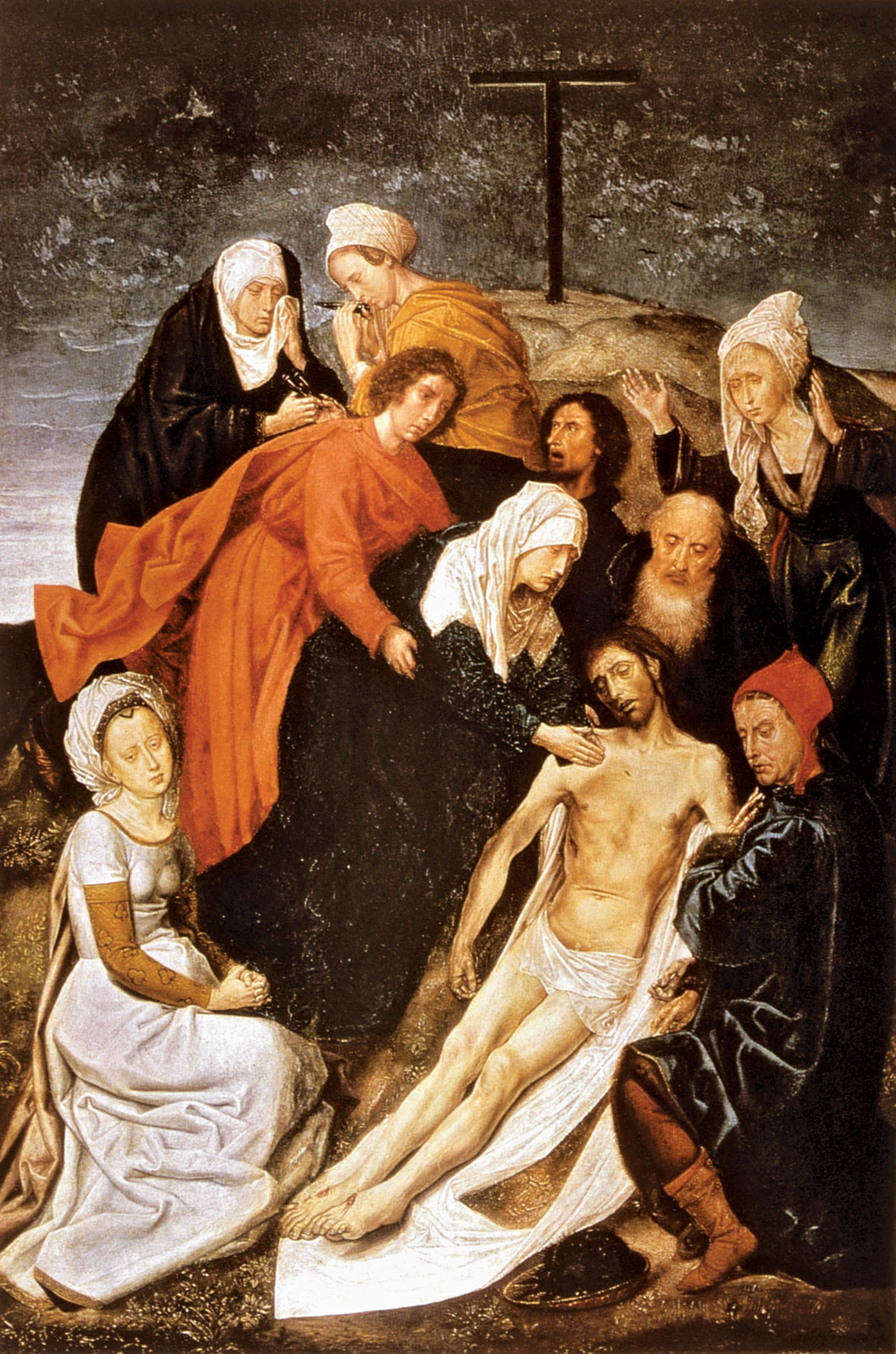 Spatial impossibilities, abstract backgrounds, the use of gold, internal framing devices and distortions in figure drawing were all methods of conveying meaning while stressing the picture’s existence as a picture, something that Hugo could have found in the work of Rogier van der Weyden. As Oettinger pointed out, Hugo’s debt to Rogier seems to have increased with age, although he made fewer direct borrowings from Rogier than from Hubert and Jan van Eyck, if the extent to which Rogier’s types had permeated south Netherlandish art is taken into account. The Ghent Altarpiece (Ghent, St Bavo), the van der Paele Altarpiece (Bruges, Groeningemus.) and the Virgin in a Church (Berlin, Gemäldegal.) were all direct sources for Hugo. Hugo’s development can be seen as one of an initial dependence on van Eyck that weakened through the influence of van der Weyden to attain an individuality, fed but untrammelled by the art of the past. In linking his creations so firmly to the physical world, van Eyck arrived at a solution where his technical brilliance left little room for further development. By distancing his images from the actual world, van der Weyden opened up unlimited possibilities and offered Hugo an alternative to the more literal descriptions of van Eyck. By the end of the century, it was said to have been Hugo’s inability to rival the Ghent Altarpiece that drove him mad, and how far his incipient madness conditioned the stylistic changes that removed his paintings even further from reality is an inevitable, but unanswerable question.
Spatial impossibilities, abstract backgrounds, the use of gold, internal framing devices and distortions in figure drawing were all methods of conveying meaning while stressing the picture’s existence as a picture, something that Hugo could have found in the work of Rogier van der Weyden. As Oettinger pointed out, Hugo’s debt to Rogier seems to have increased with age, although he made fewer direct borrowings from Rogier than from Hubert and Jan van Eyck, if the extent to which Rogier’s types had permeated south Netherlandish art is taken into account. The Ghent Altarpiece (Ghent, St Bavo), the van der Paele Altarpiece (Bruges, Groeningemus.) and the Virgin in a Church (Berlin, Gemäldegal.) were all direct sources for Hugo. Hugo’s development can be seen as one of an initial dependence on van Eyck that weakened through the influence of van der Weyden to attain an individuality, fed but untrammelled by the art of the past. In linking his creations so firmly to the physical world, van Eyck arrived at a solution where his technical brilliance left little room for further development. By distancing his images from the actual world, van der Weyden opened up unlimited possibilities and offered Hugo an alternative to the more literal descriptions of van Eyck. By the end of the century, it was said to have been Hugo’s inability to rival the Ghent Altarpiece that drove him mad, and how far his incipient madness conditioned the stylistic changes that removed his paintings even further from reality is an inevitable, but unanswerable question.
Working Methods and Technique.
Hugo van der Goes: Portrait of a Man, oil on…The Monforte Adoration shows that Hugo must have had a thorough training in the meticulous oil-painting techniques conventional in the Netherlands (see fig.). The increasing emphasis on surface apparent in his compositions is reflected in his technique. In the Bonkil panels, the Nativity and the Lamentation, he textured hair and beards by drawing a dry brush or point through the wet paint. With the flatter colors of the Nativity and the Death of the Virgin, he used fewer glazes, relying on juxtapositions of colour instead of over-layering, producing a thinner paint layer. He was probably a significant contributor to the loosening of paint application and the simplification of technique found in many south Netherlandish painters of the later 15th century.
Where paint is thin, as in the Lamentation, Hugo’s underdrawing is visible to the naked eye; elsewhere infra-red light is needed. Most hesitant in the Monforte Adoration, his underdrawing tends to concentrate on outlining contours and major internal details, and on shading with broad hatching strokes. Sometimes, as in the head of the Scottish prince in the Bonkil panels, the preoccupation with wider areas of tonal definition allowed the hatching to obscure the features, whereas in the head of his mother the lines are more directional and employed to define shape. Compositions must have been planned through detailed preparatory drawings, for there are few major changes between underdrawing and painting, except in the wings of the Portinari Altarpiece, while in its central panel the Child was realigned after painting.
The two surviving drawings with the strongest claims to be autograph, both on coloured grounds with ink and white gouache, may be careful records made for the workshop stock of patterns rather than as preparatory studies. The Jacob and Rachel (Oxford, Christ Church Pict. Gal.) is a complete scene and the Seated Female Saint (U. London, Courtauld Inst. Gals) has been shown by Campbell (1985) to be a figure of St Ursula from a Virgin and Child with Female Saints, the lost original best reflected in a painted version (Rome, Gal. Acad. N. S Luca) and in the Grimani Breviary (Venice, Bib. N. Marciana). As a St Barbara or St Catherine, the figure was one of the most repeated patterns of the so-called Ghent–Bruges school of illuminators.
The number of compositions that seem to derive from lost originals by Hugo is large, and it is possible that some of his designs never progressed beyond drawings or were paintings left unfinished at his death, a suggestion made by Held for the St Hippolytus triptych (Boston, MA, Mus. F.A.). Since, according to Ofhuys, Hugo needed at least nine years to complete the works that troubled him, they must have been definite commissions or projects that had achieved some physical manifestation. He had no obvious painter heir to inherit his stock of patterns, but it seems likely that some at least survived to be used by others—some, not all—for the Portinari Altarpiece seems to have had few repercussions in the Netherlands, unlike the Bonkil panels, which did, even though they were also exported.
It is of relevance to the spread of Hugo’s art that a significant number of surviving paintings on cloth can be associated with him. The fragility of both the support and the size medium makes it hard to compare them with the panels, but some, such as the Virgin and Child with Instruments of the Passion (Nuremberg, Ger. Nmus., on loan to Munich, Alte Pin.) and the divided diptych with the Descent from the Cross (New York, Wildenstein’s; Berlin, Gemäldegal.), have been claimed as autograph. Despite the use of lapis lazuli on the former, it is likely that the cheaper and easily transportable cloth paintings were a way of maximizing return on compositions worked out for more expensive panels. If Hugo did invent directly for cloth paintings with their quicker technique, it would help to explain the disproportion between the length of his working life and the number of his works. He must have employed assistants, and his helperen are specifically mentioned in the Ghent accounts for 1468–9.
Tradition and Innovation
Hugo’s popularity may have resulted from his assimilation of established conventions, which made his new formulations of existing types and subjects stimulating but not shocking. His advances in landscape construction and in the exploitation of its expressive potential can be set within a developing trend to which he gave new impetus. The written evidence makes David and Abigail, with its landscape setting, his most famous painting. Abigail was a type for the Virgin but an unusual choice for an independent scene, perhaps selected as much for its pictorial possibilities as its meaning. The two other Old Testament subjects associated with Hugo also require landscapes: Jacob and Rachel and Hagar Driven into the Desert, partially recorded in a drawing (Boston, MA, Mus. F.A.). He also set the Virgin and Child in a landscape, if van Mander’s description of an epitaph painting in the St Jacobskerk, Ghent, can be believed, a type increasingly adopted in the later part of the century.
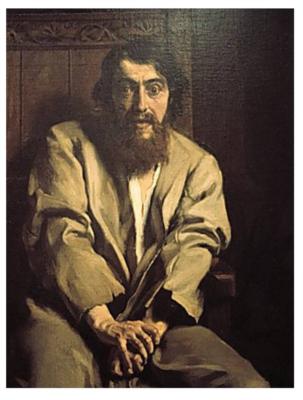 While Hugo clearly learnt from the Ghent Altarpiece and other Eyckian models, his landscapes also reflect more recent north Netherlandish tradition. The apparently early David and Abigail, judging by surviving versions, used Bouts’s device of overlapping hills to establish recession, whereas the Fall of Man and Jacob and Rachel share an ability to unite foreground, middle ground and background and to set figures in, not against, landscape. The flatter, more continuous landscapes were achieved through lowering the viewpoint and giving a new emphasis to the middle ground, bringing buildings forward from their usual place on the horizon and giving them a contemporary appearance to relate them to the viewer’s experience of the actual world. This device can be seen in Jacob and Rachel and the St Hippolytus donor wing (Bruges, St Salvator) and the small landscapes of the Monforte Adoration and Portinari Altarpiece.
While Hugo clearly learnt from the Ghent Altarpiece and other Eyckian models, his landscapes also reflect more recent north Netherlandish tradition. The apparently early David and Abigail, judging by surviving versions, used Bouts’s device of overlapping hills to establish recession, whereas the Fall of Man and Jacob and Rachel share an ability to unite foreground, middle ground and background and to set figures in, not against, landscape. The flatter, more continuous landscapes were achieved through lowering the viewpoint and giving a new emphasis to the middle ground, bringing buildings forward from their usual place on the horizon and giving them a contemporary appearance to relate them to the viewer’s experience of the actual world. This device can be seen in Jacob and Rachel and the St Hippolytus donor wing (Bruges, St Salvator) and the small landscapes of the Monforte Adoration and Portinari Altarpiece.
In the Nativity the Annunciation to the Shepherds appears in a background landscape, where the hovering angel is the light source irradiating the shepherds. Hugo seems to have been the originator of a nocturnal Nativity, where light from the Child in the manger dramatically lit the Virgin and other worshippers, with the annunciating angel as a subsidiary light source in a similar background incident, as seen in versions attributed to Gerard David and Michel Sittow (both Vienna, Ksthist. Mus.) and in the Grimani Breviary and other Ghent–Bruges manuscripts. The extreme contrasts of light and dark would have been awkwardly conveyed in a drawing, and the original must thus have been a painting accessible at least to the initiator of the chain of imitations and variants.
Hugo seems to have been most faithfully copied in his half-length compositions, which were smaller and more easily exactly repeatable. He did not invent the half-length narrative, for van der Weyden had originated a half-length Descent from the Cross, but he does seem to have used the form more than any of his predecessors and with an inventiveness only exceeded by Bosch. Some seem to have been reworkings of larger compositions: an Adoration of the Magi (versions in New York, Met.; Copenhagen, Nmus.) is closely related to the Monforte Adoration, and another Nativity (version Wilton House, Wilts) is related to the Nativity (Berlin, Gemäldegal.).
Hugo’s most famous half-length, to judge from the 200 odd copies still extant, was a broad format Descent from the Cross (versions Naples, Capodimonte; Amsterdam, Rijksmus.), perhaps derived from his lost Descent from the Cross altarpiece that stood in the St Jacobskerk, Bruges. The gold back wall with a cornice, some of the figures and their restricted grouping are taken from van der Weyden’s great Descent from the Cross (Madrid, Prado). Here and in the half-length diptych with the Descent, which has slightly more movement, Hugo successfully abstracted iconic images from narrative, the diptych form allowing a perfect balance between the two focal-points, Christ on the left wing, the Virgin on the right. Versions of both compositions of the Descent from the Cross, attributable to Hugo’s workshop, if not his own hand, survive on cloth (fragment of horizontal format, Oxford, Christ Church Pict. Gal.), and these smaller, close-up compositions were more widely available than the great altarpieces and also more accessible as visual and emotional experiences. That the most successful was derived in composition as well as type from van der Weyden demonstrates again how Hugo, inspired but not restricted by Rogier’s dominating influence, came to rank with him as a creator of patterns central to the development of Netherlandish art.
